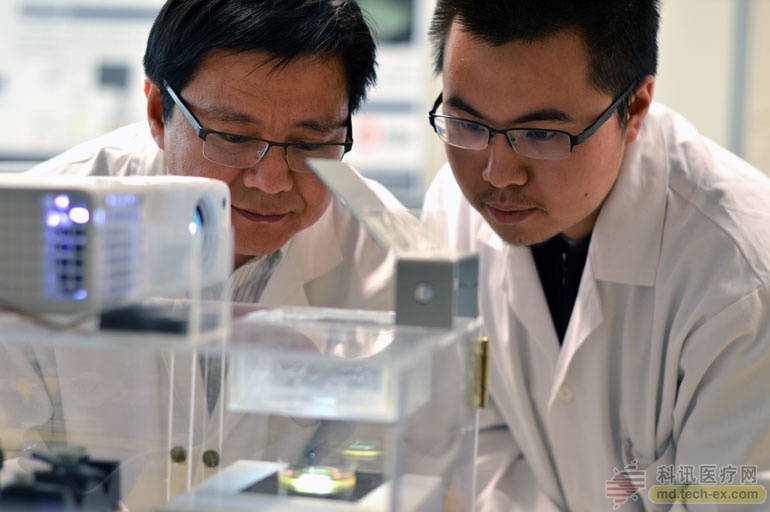Release date: 2016-04-19

A few days ago, scientists at the University of British Columbia (UBC) in Canada developed a compound that allows you to create biological tissue by simply buying a light projector from Wal-Mart.
The compound is said to be a new bio-ink for 3D printing organization, and no longer requires a UV light system for a safer, more conventional light source.
"It is well known that UV light can cause cancer and damage DNA in cells, so if you use it to create tissue for medical purposes, the effect is not ideal." Keekyong Kim, assistant professor of engineering at UBC Okanagan, said: "By developing our own Bio-ink, we can bioprint bone, cartilage and tissue, and there is no risk of cells in the process."
Professor Keekyong Kim (left) and his student Zongjie Wang are observing tissue samples
During his research, Kim used stereolithography (SL) technology, a very common 3D printing technique that creates 3D objects by layering the photosensitive material layer by layer.
It is understood that during its 3D printing process, cells combine with bio-ink to form a thicker gel-like material when exposed to light, called a hydrogel. This hydrogel can be used as a scaffold system to grow bones or tissues in the desired shape, and it will decompose under the action of enzymes when the cells are regenerated.
The key to Professor Kim's research is this photo-initiated compound, which allows bio-inks to be cured using only ordinary projectors. Such conventional projectors were previously used to print plastic 3D models rather than biological materials.
“With this photoinitiator, we were able to use a more traditional light source that was not really tried in previous 3D bioprinting.†Kim said: “The result is that we can be more secure than one. And cheaper methods to create medical organizations.
Kim and his team's research has now been published in the journal Biofabrication.
Source: Tiangongshe
Rabies Vaccine (Vero Cell) for Human Use, Freeze-dried is a preparation of rabies fixed virus CTN-1V inoculated into Vero cell. After cultivation by bioreactor, harvest the virus suspension; further perform the concentration, inactivation, and purification. The vaccine is formulated by adding human albumin, dextran 40 and sucrose through freeze-drying process. The freeze-dried vaccine looks like a white crisp cake which turns into a transparent liquid after reconstitution, without any preservative. Active ingredient: inactivated rabies fixed virus. Excipients: Human albumin, dextran 40, sucrose, sodium chloride, potassium chloride, potassium phosphate monobasic, dibasic sodium phosphate. Diluent for vaccine: sterile water for injection. The specification is 0.5ml/vial after reconstitution. 1 vial (0.5ml) per single human dose. The vaccine titer should be not less than 2.5IU.
Rabies Vaccine For Human,Human Freeze Rabies Vaccine,Human Rabies Vaccine Storage,Freeze Rabies Vaccine For Humans
Changchun Zhuoyi Biological Co., Ltd , https://www.zhuoyi-bio.com